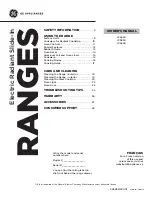
_ Hob _ rev. 0 _____________________________________________________________________ KP 96 – KTP 96 _
_ CATEGORY II2H3+ _ GB __
0705
______________________________________________________ page 8 _
2. Positioning
Mod. KP 96
- The appliance must be laid on a work table, away from furniture (class 1). The
minimum distance from rear and side walls must be at least 10 cm.
Mod. KTP 96
- The appliance may be positioned away from furniture (class 1) or be fitted in between
two items of furniture (class 2 - subclass 1). In any event, the rear wall must be at a distance of at least
10 cm.
3. Instructions for the installer
Dear Sir/Madame, thank you very much for having purchased our product. The following warnings
and suggestions concern the procedures to be followed for a correct installation, use and maintenance
of the appliance, to safeguard your safety as well as to obtain the very best performance from the
characteristics of the appliance.
General information
- To install and use any electric appliance a few fundamental rules must be
respected. This appliance must be installed by specialised personnel in accordance with the
regulations in force. Any maintenance or adjustment intervention must be carried out with the appliance
unplugged from the power source.
Warning: Gas cooking appliances produce heat and damp in the room where they are located. An
adequate airing of the room must be ensured by keeping every natural ventilation orifice open or by
installing an inlet hood fitted with a waste pipe.
Place of installation
- For the gas appliance to work correctly, the gas combustion must be supplied
by enough air reaching the room in a natural way. (The installer must abide by the current national
installation norms and subsequent amendments). The air circulating into the room must arrive directly
from openings made in the external walls. Such openings must have a clear 100 cm
2
cross section
area for the air flow and a 100 cm
2
one to discharge combusted gas. Should other gas operating
appliances be installed, such openings must be appropriately enlarged. These openings must be
located in such a way as not to be obstructed from either the inside or the outside. The opening
allowing air circulation must be placed close to the ground, whilst the one used for the combustion
discharge must be located on the high side of an external wall. Could not these openings be made in
the same area where the appliance is installed, the amount of air needed could also come from an
adjacent room, provided that this is not a bedroom nor a dangerous area and that it is appropriately
ventilated (current national installation norms and subsequent amendments).
Discharge of combustion products
-
Gas type cooking appliances must discharge the combusted
products through hoods connected to the chimney flue or directly to the outside. The hood must be
positioned at least 700 mm far from the working surface. Keep this distance also when installing
components or shelves horizontally above the appliance. In case a hood could not be installed, an
electric ventilation unit must be applied to the external part of the room or to a window, provided that
the room is fitted with openings for air circulation (the current national installation norms and
subsequent amendments). The electric ventilation unit must ensure an air circulation rate equivalent to
3-5 times the volume of that room per hour.
Warning: an intense and prolonged use of the appliance may require additional aeration, which could
be achieved opening a window or increasing the mechanical inlet power, where it exists, consequently
improving the airing efficiency.

































